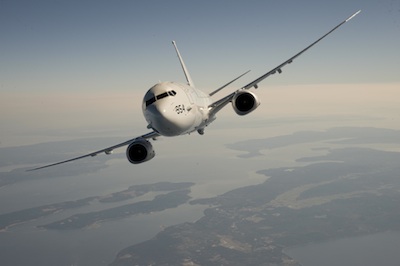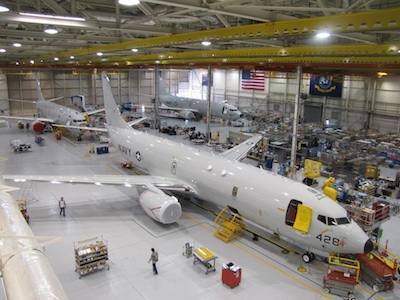
News
The Boeing P-8A
 Aug. 22, 2011 – Fred Smith and James D. Detwiler of the Boeing P-8
International Programs held a briefing in Ottawa on Aug. 18, 2011 to
introduce the P-8A Poseidon to the media.
Aug. 22, 2011 – Fred Smith and James D. Detwiler of the Boeing P-8
International Programs held a briefing in Ottawa on Aug. 18, 2011 to
introduce the P-8A Poseidon to the media.
August 22, 2011 By Peter Pigott
Aug. 22, 2011 – Fred Smith and James D. Detwiler of the Boeing P-8 International Programs held a briefing in Ottawa on August 18, 2011 to introduce the P-8A Poseidon to the media. A long-range anti-submarine warfare, anti-surface warfare, intelligence, surveillance and reconnaissance aircraft capable of broad-area, maritime and littoral operations, the P-8A is a derivative of the Next-Generation Boeing 737-800-which is familiar to Canadians as part of the Westjet fleet. Using the 737-800 as a base model was an economy of scale for Boeing as the same factory and workforce could also build the basic P-8A.

|
|
|
|
A Boeing-led industry team developed the aircraft for the US. Navy which plans to purchase 117 P-8As to replace its fleet of P-3C aircraft. Initial operational capability is slated for 2013. On Jan. 1, 2009, in a historic coup, Boeing also signed a contract with the Government of India to provide eight P-8I long-range maritime reconnaissance and anti-submarine warfare aircraft to the Indian navy. Australia signed an MOU with the U.S. Navy in 2009 and will collaborate further. Boeing hopes that the Canadian government will consider the P-8A as a replacement of its aging fleet of CP-140 Auroras currently undergoing a life extension program.
General Characteristics: Propulsion: Two CFM56-7 engines providing 27,000 pounds thrust each
| Length | 129.5 feet (39.47 metres) |
| Wing Span | 123.6 feet (37.64 metres) |
| Height | 42.1 feet (12.83 metres) |
| Maximum Takeoff Gross Weight | 189,200 pounds (85,820 kilograms) |
| Speed | 490 knots (564 mp/h, 789 km/h) |
| Range | 1,200+ nautical miles, with four hours on station (1,381 miles, 2,222 kilometers) |
| Ceiling | 41,000 feet (12,496 metres) |
| Crew | 9 |
The first P-8A Poseidon production aircraft completed its first flight on July 7, 2011, taking off from Renton Field and landing three hours later at Boeing Field in Seattle. “As the Navy’s replacement for the P-3 Orion, the P-8A Poseidon represents the next generation of maritime patrol and reconnaissance aircraft,” said Capt. Michael Moran, program manager for Naval Air Systems Command’s Maritime Patrol and Reconnaissance Aircraft program office. At present 16 P-8As are being produced annually and the U.S. Navy is slated to have the first P-8A squadron in operation by 2013.

|
|
|
|
Smith and Detwiler pointed out the advantages of a P-8A in Canadian military service with assets making it especially suitable to Arctic sovereignty: air refueling capability (that the CP-140 does not have) that would increase its range and allow it to loiter longer; enhanced de-icing capability because of raked wingtips that allow it to fly low for SAR purposes; a weapons bay for torpedoes or SAR materials and its CFM-567 engines that are very “dollar intensive.” Even with the service life extension, a replacement for the CP-140s will have to be named soon.